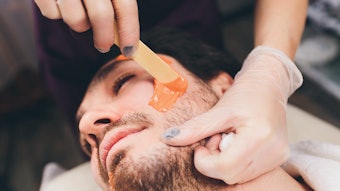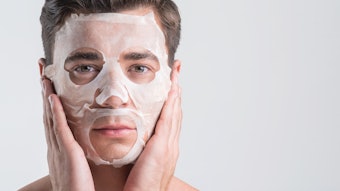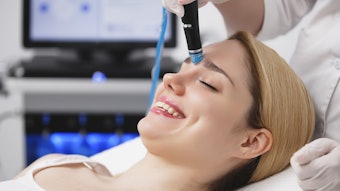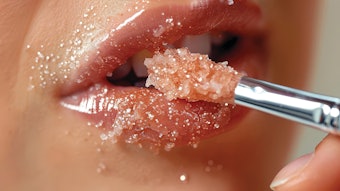
A recent study examining perception of a person’s age by the appearance of blotchy, uneven-colored facial skin has confirmed what the cosmetic industry has known for ages—the appearance of fewer age spots equates to younger-looking skin.
The study tested a person’s ability to assess another person’s age by the appearance of their facial skin. Members of a panel were shown a series of photographs of different faces. There were photos of a person with unevenly colored skin—including sun spots and pigmentation marks—compared with identical photos of the same person but with the pigmentation problems digitally removed. The study revealed the panel members overwhelmingly scored the person with no blemishes to be of a younger age. Perhaps not a surprising outcome, but it at least confirms the perception of people with clear, even-colored skin as more youthful and healthy.
More seriously, in some Asian cultures pigmentation spots can often be a source of great social embarrassment. Superstitious beliefs exist that indicate dark spots may confer bad luck to a person or imply she will never be wealthy. In such cases, pigmentation problems go beyond the cosmetic realm and encroach upon broader sociocultural issues.
Apart from this, however, there are many reasons why people seek treatment to remove unwanted pigmentation. As a world of sun-lovers, many have done damage at the beach, the park or even in the front yard during the carefree days of youth and adolescence. Many were even encouraged by well-meaning—but misguided—relatives that a bit of color would “do you good.” For those of Celtic origin, the only good to come of it has been a freckled complexion, particularly in prominent places such as the tip of the nose, the lips or around the eyelids.
Reasons for concern
Concern over pigmentation spots can range from those of a cosmetic nature through to potentially fatal skin cancers such as melanoma, and thus the motivation for some individuals to maintain a pigmentation-free face may be seen as more therapeutic than cosmetic.
To further complicate the issue, not all pigmentation is created equal. In some cases it may manifest as superficial freckles. In others, it may present as diffuse, blotchy brown discoloration. These differences reflect the many and varied causes of pigmentation, which can range from simple sun exposure to complex hormonal issues. So, before treatment can begin, the correct diagnosis is essential.
If the cause of the pigmentation is uncertain, referral to a specialist physician or dermatologist will be necessary. Malignant skin cancers masquerading as pigmentation may be easily dismissed at a quick glance, and the consequences of missing a malignant skin lesion could have devastating repercussions for both the client and the skin care professional.
For the client, a delayed diagnosis may mean the difference between a simple curative procedure, such as freezing with liquid nitrogen, or later to disfiguring reconstructive surgery, radiotherapy, chemotherapy and even death. For the skin care practitioner, a missed diagnosis could lead to legal proceedings, loss of professional reputation and financial ruin.
Treatment choices
So how are pigmentation problems treated? Assuming the pigmentation is benign, there are several treatment options to safely remove these lesions. The treatment choice will be determined by the working diagnosis, the location of the lesion, and the client’s skin type—fair, olive or dark. Treatments range from topical creams and lotions to peeling agents, cryogen, laser and light-based devices, and surgery.
One of the most common causes of pigmentation is freckles. These are spots located superficially in the epidermis and, for this reason, are amenable to various treatments. Often present from childhood due to excessive sun exposure, most will fade and disappear as children grow into adults, provided they limit their sun exposure. Topical exfoliating agents such as retinoic acid, and alpha and beta hydroxy acids can be very effective, particularly if combined with microdermabrasion.
Deeper skin peeling agents, such as higher concentration AHAs, BHAs or trichloracetic acid, applied by an esthetician or physician, will help to clear deeper-seated melanin. Broadband light devices (IPL) or visible light lasers, often around the green wave length, are more specific in targeting the melanosomes and have greater efficacy. For more stubborn pigment, which is usually located deeper in the dermis, the Q-switched lasers such as 695nm and alexandrite 755nm lasers are the instruments of choice. Such simple freckles are relatively easy to treat and most will respond quickly to lasers or peeling treatments.
In older people, larger freckles, called lentigines, may develop due to chronic sun exposure. Caution needs to be exercised in patients older than 50 before simply treating these as freckles, as they can mimic a Hutchinson freckle, which is technically a malignant melanoma. It is often best to refer older patients to a specialist dermatologist for a skin check before beginning any cosmetic treatment.
Melasma or chloasma can be one of the most frustrating types of pigmentation to treat. The diagnosis is usually easy to make just on appearance. It occurs predominantly in females and darker skin types such as Asian, Mediterranean and Indian. The melasma pattern of pigmentation is blotchy but symmetrical—typically affecting the forehead, top lip and malar cheeks areas. Color varies from light tan to dark brown. The melanin may be in both the epidermis and deep dermal layer; a Woods light examination can determine this. It appears that female hormonal activity is a factor, as the onset of melasma is often seen in women taking the oral contraceptive pill or during pregnancy. Some medications, creams or cosmetics that increase sun sensitivity also play a role in its development. The most important factor is ultraviolet light exposure. Most treatments fail because of this.
Some melasma is temporary and will reverse after pregnancy or cessation of the pill. Also, bleaching agents such as retinoic acid, azelaic acid and ascorbic acid may be used to treat this blotchy pigmentation, but whatever is tried, including cleansers, it should not be overly irritating to the skin.
Potential problems
Superficial skin peels such as glycolic or lactic acid can be added, but deeper peels increase the risk of increasing pigmentation. Similarly, IPL and lasers are not the first choice of treatment for this type of pigmentation, as they can worsen the problem by creating rebound post-inflammatory pigmentation. If they are used, extreme caution is necessary to minimize this risk.
Other pigmentation problems affecting the face that are successfully treated by dermatological lasers are the acquired Nevus of Ota-like pigment, or Hori’s nevus, which is often mistaken for melasma, the difference being that the Q-switched lasers such as Nd:YAG, ruby and alexandrite are the treatment of choice for these deep dermal pigmentations. These pigmentation problems have, in the past, been completely removed only to see the patient returning later with melasma appearing, often with the practitioner not understanding the new pigmentation cannot be treated in the same way. Finally, various facial brown and black naevi, or birthmarks, such as Nevus of Ota and café-au-lait marks, can be successfully removed by laser with little to minimal scarring.
The right course
It must be stressed that all pigmentation needs careful assessment to ensure appropriate treatment. Constant vigilance to the possibility of melanoma or other actinic changes is required in order to avoid treating such lesions inappropriately. Lasers may often not be the best treatment for pigmentation as the risk of worsening the condition is very real, especially in darker skin types.
Despite this, many types of pigmentation can be successfully treated using the modalities discussed above. An experienced practitioner will fully assess the situation and recommend the most suitable treatment option. Treating such pigmentation is beneficial for the cosmetic reasons mentioned above—a clearer, more uniform complexion is perceived as being more youthful—as well as for medical reasons, because assessment of pigmentation problems can lead to the early diagnosis and treatment of potentially serious problems.
This article originally was published in the April 2007 issue of Professional Beauty magazine and is being reprinted with permission. All rights reserved.










